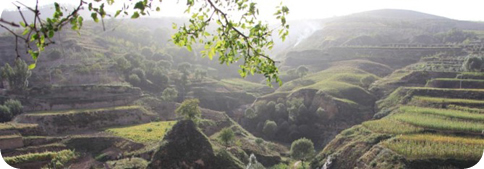Lessons of the Loess Plateau
Produced and directed by John D. Liu. 2009. 52 minutes.
In English.
Study areas: Northern China, Environmental Studies, Agriculture, Sustainable Development

With footage of stark landscapes, evocative images of villagers, and haunting folk song performances reminiscent of the 1984 film Yellow Earth, John Liu introduces the viewer of his 2009 film Lessons of the Loess Plateau to a culture and place that is surely one of the most intriguing and important on earth. For many in the West the Loess Plateau in China remains an alien and little known part of the Middle Kingdom. The Loess Plateau is a physiographic region in Northern China characterized by a deep mantle of wind deposited silt. Loess deposits in this region can reach great depths and are associated with distinctive landforms and ecosystems. Traditionally, people living in the Loess Plateau adapted well to these conditions by developing unique architectural, agricultural, and settlement patterns.
The purpose of this film is not just to explore such unusual physical and cultural characteristics. Its primary purpose is to document a large scale environmental restoration project undertaken by the Chinese government and the World Bank in the region. It is widely acknowledged that the Loess Plateau has suffered a great deal of human accelerated soil erosion and disruption to native ecosystems. Long ago sediment suspended in the main river traversing the region gave rise to its name, the Huang He, or Yellow River. Although a certain amount of soil erosion in this region is natural, the rate of topsoil loss is now far beyond the natural rate. Eroded topsoil both reduces agricultural production and causes serious problems downstream with extreme sedimentation and increased flooding.
The good news communicated by this film is that even though the degradation has been extensive, steps have now been taken to significantly improve the sustainability of both the natural and human communities. Before and after scenes show a tremendous change in the amount of vegetative cover in the landscape as well as the apparent fortunes of the residents. What were once gullied and barren landscapes now appear terraced and verdant. Villagers interviewed in the film recall earlier periods when famine and extreme poverty were common. In the latter parts of the film, the local residents are seen living in newly constructed homes, picking fresh apples, and feasting on abundant food.
The film gives us some idea of how such a dramatic transformation was accomplished. Some imported expertise was involved, for example with GIS mapping and dam construction. However, it seems that one of the most significant reasons for this project’s success has to do with involving village residents both in the planning and implementation. Many farmers were simply hired, with the funds made available from the government and the World Bank, to provide manual labor. Beyond that, one of the critical factors in this story has to do with land rights. Poor farmers in the Loess Plateau, like poor farmers in almost everywhere else in the world, are concerned about who owns the land and how much land they might acquire. This film shows that local communities were charged with the task of equitably creating new property lines and re-allocating property rights. Individual families were given long term leases to plots of land. Whatever improvements they were asked to undertake, such as terracing and tree planting, were to be done with the idea that they would be the direct beneficiaries.
This film asserts that the approach taken in the Loess Plateau might be applied to similar degraded environments in other parts of the world. Footage is shown of potential agricultural areas of South Asia and Africa. There is indeed much that can be learned from the efforts in the Loess Plateau, and educators should be able to generate a lively discussion about what aspects of this approach are transferable.
Lessons of the Loess Plateau would be especially appropriate for courses dealing with China, agriculture, and sustainable development. It could be used in classroom settings with advanced high school students to introduce terms and concepts such as loess, soil erosion, sedimentation, and climate change. Students in undergraduate courses on China or environmental studies might also find the film to be a good introduction to such concepts as well as serving as a colorful gateway to understanding this particular environment and culture. Advanced undergraduates might find this a good subject for more critical analyses. For example, the film glosses over the impacts of the feudal system, civil wars, the devastating famine associated with the Great Leap Forward, the Cultural Revolution, and agricultural and economic policy changes after 1980. Was most of the degradation really the result of poor decisions and ignorance on the part of the farmers, as the film suggests, or was it more the result of economic constraints and extreme poverty caused by decisions in Beijing or imposed by feudal practices?
James Mills is Associate Professor of Geography and the former director of the Environmental Sciences Program at SUNY Oneonta. He teaches courses on East and Southeast Asia and is currently chair of the President’s Advisory Council on Sustainability at Oneonta.
Photo Credit: Kosima Weber Liu
Lessons of the Loess Plateau is available to view online at the Environmental Education Media Project. click here to view
Educational resource materials and film clip of Lessons of the Loess Plateau may be found at www.digitalasia.illinois.edu
Last Updated: January 18, 2012

